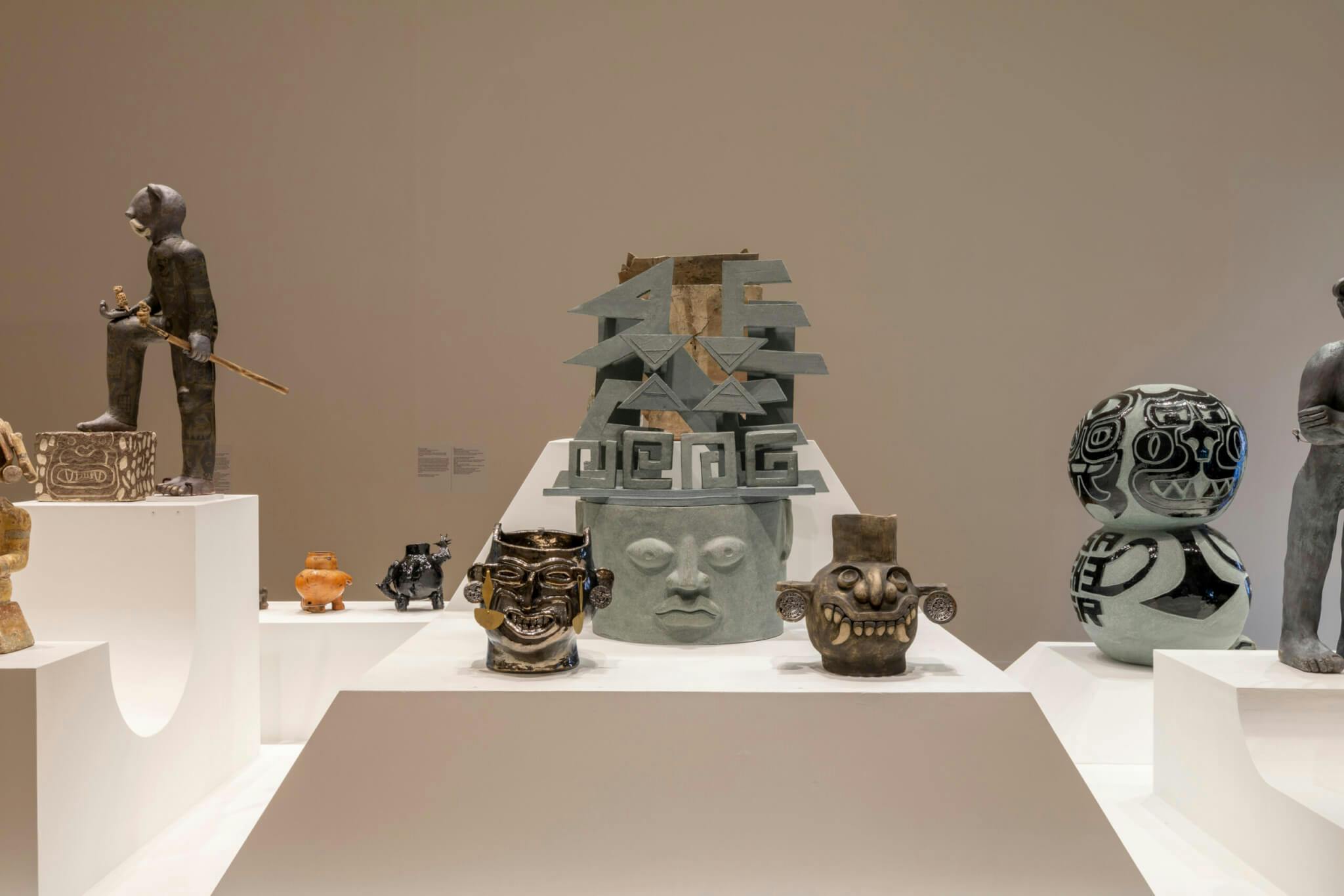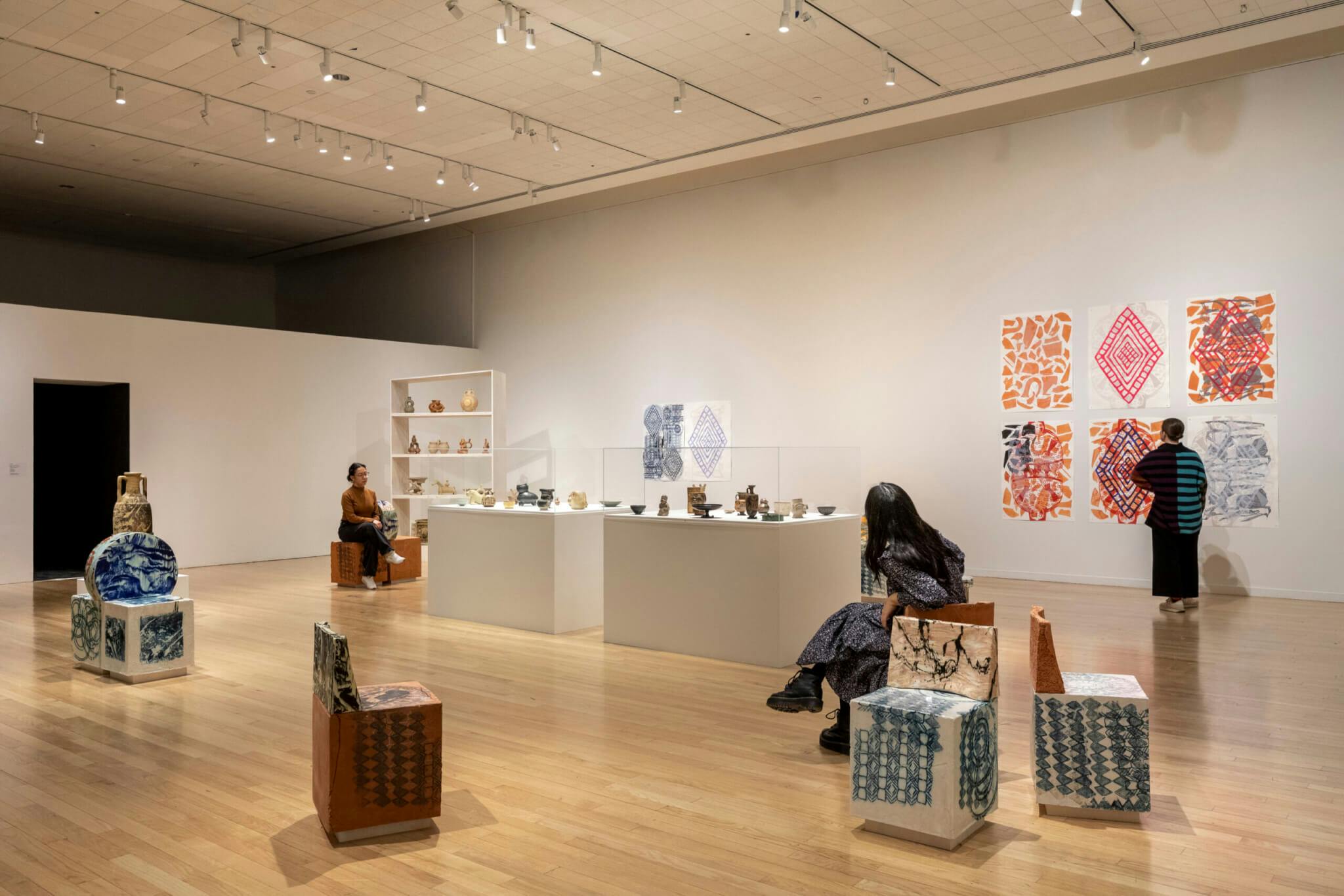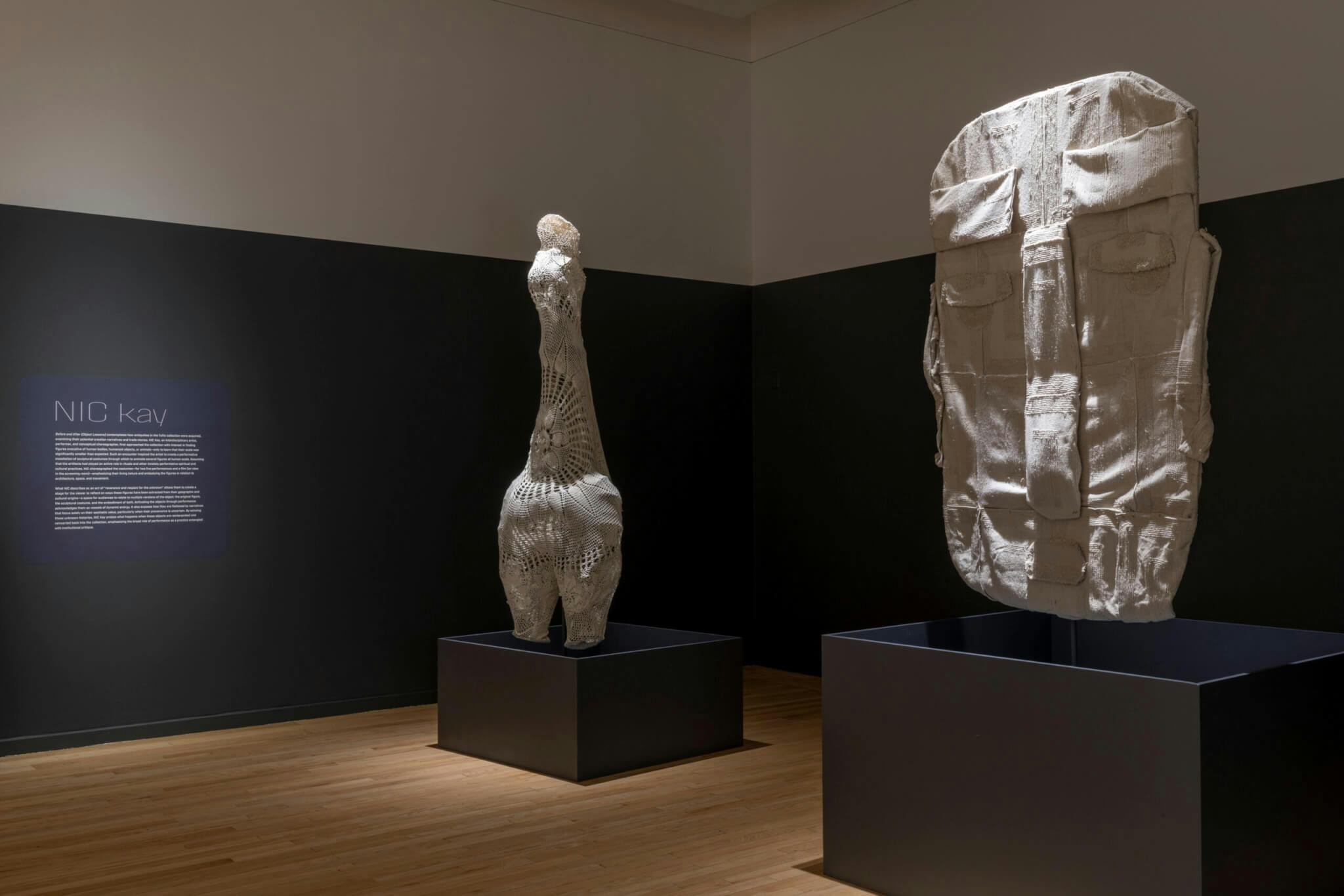Tufts University Art Galleries (TUAG) has approximately 2,400 works in its collection, two hundred of which are antiquities. As part of its mission to be an anti-racist institution, it is examining its collection to more thoroughly understand the objects, where they came from, and what they represent. In the spirit of Andy Warhol’s 1969 exhibition “Raid the Icebox” and inspired by Clémentine Deliss’s book The Metabolic Museum, the curators invited four artists—Ali Cherri, Nicole Cherubini, NIC Kay, and the duo SANGREE—to bring fresh eyes and new approaches to help them interrogate their holdings. Spread across TUAG’s two campus locations, in Boston and Medford, the exhibition is exhaustive yet surprising.
SANGREE (the Mexico City–based duo of René Godínez Pozas and Carlos Lara) opens the Medford exhibit. At first glance, the installation, with its long title, The Gifts Offered to the Ones to Come: Ooparts from the Distant Future (Los dones que se ofrecen a los que están por venir: Ooparts de un futuro distante), appears to be ancient artifacts without protective glass, on a plinth. (Ooparts, for those who don’t know, are “out-of-place artifacts.”) Upon closer inspection, though, among the terra-cotta statues, plates, bowls, effigy vessels, and incense burners is a pair of slides, straight out of a Nike store, made from marble. There’s a hunched-over ceramic figure staring at a cell phone. A black lacquered creature is reminiscent of Donkey Kong. The rim of a terra-cotta plate is branded with SANGREE in big block letters. And the plinth, with its platformed pyramids, half-pipes, and ramps, was inspired by Mesoamerican architecture and urban skate parks. The installation makes us reflect on what we collect and what we value: a pot 1,000 years ago might be Nike slides or a cell phone today.
Behind SANGREE’s work, occupying the back of the Medford gallery, is Nicole Cherubini’s Loot Garden, 2023, a sprawling installation of antiquities, ceramic chairs, and colorful prints. Two display cases and a large open shelf contain bowls, jars, and other vessels that pay no attention to region or time period. Cherubini researched the objects by function, putting “vessel” and “pot” in her search. Pulled out of context and grouped according to their beauty and use, the pieces create a democratic display, one determined by the object, not by the curator or collector. The selected antiquities served as source material for her vibrant and surprisingly comfy “garden” chairs and a series of prints that decorate the back wall. It is a welcoming room, with an invitation to “please sit” that satisfies a desire to linger and look.
Adjacent to Cherubini’s work is NIC Kay’s Before and After (Object Lesson), 2022. An interdisciplinary artist, performer, and choreographer, Kay chose two archetypal forms, made from the material of the time, a stone Head, Chontal Style (sixth–second century BCE, Mezcala, Chontal) and a terra-cotta Female Figurine (1000–800 BCE, Northwest Iran/Near Eastern), and reimagined them for the present. Kay was struck by how small these artifacts were considering their importance in rituals. The response was to create two larger-than-life imitations, made from today’s impermanent materials that they found at the dollar store, including crocheted blankets and bath mats. Two performances in the exhibition space and a film in the screening room next door seem to activate and animate the figures, giving them a spirit and dignity.
Each of these displays makes us think of how we interact with our “rare” or “precious” objects. Many of the artifacts are not behind glass—they are out on funny-shaped plinths, displayed on shelves that one might have in their home. Cherubini’s chairs are for sitting, her objects are grouped by function. The SANGREE pieces are playful. Kay’s are approachable. The reverence is turned on its head and viewers are given the opportunity to look at the objects, and the collection, through a different lens.
In the Boston gallery, Ali Cherri, a Lebanese artist and filmmaker, takes this a step further and leaves the objects he chose, a group of archaeological heads, in their crates and containers and stacks them in a darkened corner of the space. His eight-minute video, Saving Face, 2023, a compilation of movies and clips including Andy Warhol’s Blow Job, flashes on the installation. Sometimes an image of the hidden work inside appears, too. The music and video seem to awaken the works from their slumber, a multimedia séance. He’s playing with what we can and can’t see. They’re “seen” because they’ve been pulled out of storage, yet they’re still invisible because they haven’t been unpacked and displayed.
The wall texts and placards spread throughout the two locations of “re:imagining collections” are welcome signposts in this conceptually demanding show. One wall text defines Provenance, Cultural Patrimony, and Collections Policy, bringing to light what museums have been grappling with for a long time but viewers might not be aware of. Who owned the object, and was it ethically obtained? Should the object be repatriated? What gets to be seen, and who decides? Museum exhibitions shape the narratives of our culture. History has shown that objects influence, collections are agendas, and exhibitions show power structures at play. Clémentine Deliss’s book (and the subject of a two-day panel, March 30–31, 2023, at Tufts Aidekman Arts Center: “The Metabolic Museum: New Pathways for Collecting”) challenges institutions with ethnographic collections to come up with new museological frameworks and to design post-ethnographic, decolonized exhibitions and museums. “re:imagining collections” is a creative and serious step in that direction.
“re:imagining collections” is on view at Tufts University Art Galleries through April 23, 2023. Organized by Dina Deitsch, Director and Chief Curator and Laura McDonald, Manager of Collections.



